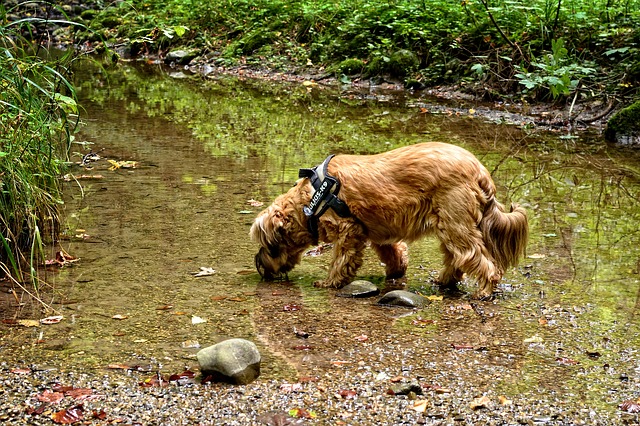Dog Training
01/16/2018
Potty Training Tips for your New Puppy
By Schylar Postle Professional Dog Trainer Potty training can be one of the biggest challenges in raising a new puppy.…
Monday – Friday
7:00 am – 7:00 pm
Saturday
7:00 am – 6:00 pm
Sunday
9:00 am – 6:00 pm
Monday – Friday
7:00 am – 7:00 pm
Saturday
7:00 am – 6:00 pm
Sunday
9:00 am – 6:00 pm

Did you read the article on CNN last week about the three dogs that died from ingesting water that had been contaminated with toxic blue green algae? Two of the dogs were in North Carolina and one was in Georgia. When we think of the blue-green algae scare, we tend to think of it as being further south, and only in coastal areas. Not so. We have active algae blooms right here in central Virginia.
The Virginia Department of Health has published a surveillance map showing active algae blooms just north/west of our area, particularly around Lake Anna. There are also a couple of active blooms near Yorktown, on the York River. That’s just too close to home. The increase of toxic blue green algae blooms is a growing problem throughout the United States.
All natural waters contain different types of algae. Algae is nothing more than a simple plant that lives in water. Although there are others, there are two very common types of algae: There is a green algae which you have known about your whole life (remember cleaning out your fish tank?), and blue green algae which is the ugly stepsister. Blue Green algae is also known as “cyanobacteria” (cyan meaning blue), as it is more of a bacteria than an algae.
Certain types of algae become harmful when there is an overgrowth. How the overgrowth occurs is not completely understood, but generally they begin to flourish when the sun, wind and current is “just right.” In addition to “natural” growth, blue green algae will also flourish and grow when it feeds on “nutrients” like phosphorus and nitrogen. These other nutrients are usually a result of run-off of fertilizer, erosion, and sewage from agricultural areas along the waterways. Whether it’s natural or aided by “pollution”, the algae produce blooms as it grows.
A bloom is nothing more than the accumulation of algae to the stage where it changes the color of the water, forms a mass, and produces an odor. Blue green algae can bloom in both freshwater and saltwater. This includes lakes, ponds, streams even decorative fountains and pools. When in full bloom it looks like a dense mass of greenish sludge floating on top of the water. Think guacamole (sorry). But you may not see it at all unless you get really close. It can blend into the water showing nothing on the surface. It can actually look like someone sprinkled a little blue-green glitter in the water. Whether it’s thick as mud, or barely perceptible, toxic blue green algae is a health hazard either way. What’s worse is the smell. A full bloom can smell like manure or rotting food. And you know how our dogs like stinky things.
Human exposure to blue green algae can produce vomiting, diarrhea, skin rashes, eye irritation, difficulty breathing, muscle weakness and possibly seizures. Blue green algae and dogs is another story. A dog can show identical symptoms, however, they will appear within minutes of being affected. If you fear that your dog may have come in contact with dangerous algae, take him to the vet immediately. Any delay in getting medical attention could prove fatal.
Blue-green algae blooms can linger for several weeks and sometimes months depending on weather and water conditions. The blooms usually do not last through the winter months because of low temperatures, but in warmer climates, the blooms may come and go all year long. As the bloom dies, it releases toxins that can remain as long as 3 – 4 months before they diminish. The problem is, we can’t tell if a bloom is actually toxic by looking at it. Not only that, but the toxin can remain in the water well after the blooms themselves have gone away.
Until someone comes up with a portable device that we can carry with us to test questionable waters, we have to be vigilant in observing any potential signs of contamination. We have devised the following list that we hope will help keep you and your dog safe:
• Keep your dog leashed when around any bodies of water until you are sure it is safe.
• If any type of scum or sludge is noticeable, don’t get in the water or allow your dog to get in the water.
• Be suspect of any water that is noticeably discolored, even when you don’t see any type of residue.
• If the water has a nasty odor, definitely stay away, but odor alone is not a good indicator of toxicity as the smell occurs only at certain stages of the life of the bloom.
• Check the shoreline for any type of green foam, and don’t get near the water if it is present.
• Check with the Virginia Department of Health to find out about recent algae blooms or to report any possible sightings of blue-green algae.
Dog Training
01/16/2018
By Schylar Postle Professional Dog Trainer Potty training can be one of the biggest challenges in raising a new puppy.…